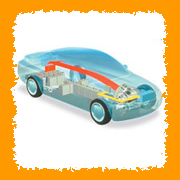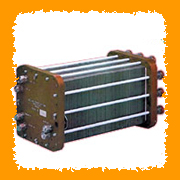Tell Me More Energy-SMART! Home
Alternative Fuel Vehicles
Most cars, trucks, and buses on the road today are designed to operate using gasoline or diesel fuel. These are nonrenewable fossil fuels that won't last forever. Finding alternatives helps to reduce harmful emissions and ensures we meet future transportation needs in a sustainable way.
Alternative fuel vehicles are designed to run on fuels other than gasoline or diesel fuel. Some of these vehicles are already on the road. Others are still in the research and development stage. As increasing numbers of vehicle companies are making alternative fuel vehicles, and research and development into them continues, fuel efficiency, driving range, and speed capacities are likely to improve.
Electric Vehicles
Since 1999, when hybrid electric vehicles (EVs) first appeared on the market, automakers have been busy designing and building new models, and there are now several types of EVs on the roads:
- Battery Electric Vehicles (BEVs) are powered only by electricity from an on-board battery, charged by plugging into the grid.
- Hybrid Electric Vehicles (HEVs) use both a gasoline engine and an electric motor to propel the vehicle.
- Plug-in Hybrid Electric Vehicles (PHEVs) use both a gasoline engine and electricity obtained by plugging into the electrical grid.
Many EVs are being designed for urban driving because they work well for short distances, lower speeds, and stop-and-go driving. These EVs are smaller than standard passenger vehicles, making them easier to park. They are also more efficient than cars with gasoline engines, and require less maintenance.
Battery Electric Vehicles
 Battery EVs run entirely on electrical energy. Instead of a fuel tank, batteries store the electricity that is used to operate the vehicle. These batteries can be recharged by plugging the vehicle into a special high-voltage charging station or standard 120-volt or 240-volt household outlets. It takes anywhere from 2 to about 20 hours to recharge the battery, depending on the vehicle’s charger and the voltage used. The batteries store the electricity until the vehicle is driven.
Battery EVs run entirely on electrical energy. Instead of a fuel tank, batteries store the electricity that is used to operate the vehicle. These batteries can be recharged by plugging the vehicle into a special high-voltage charging station or standard 120-volt or 240-volt household outlets. It takes anywhere from 2 to about 20 hours to recharge the battery, depending on the vehicle’s charger and the voltage used. The batteries store the electricity until the vehicle is driven.
Early types of battery EVs included golf carts, scooters, and other vehicles used for short trips at low speeds. With rapid industry growth this decade, battery EVs can accommodate both city and highway driving needs. Smaller models designed for urban use can travel 30-75 mph and go 50-85 miles on a charge. The high-end Tesla can reach speeds of 150 mph and travel more than 300 miles on a single charge.
Under the hood, a battery EV consists of an electric motor, one or more controllers, and batteries. The controller governs the amount of electricity that flows from the batteries to the motor when the driver steps on the accelerator. The motor changes electrical energy from the batteries to mechanical energy, which makes the vehicle move.
Driving a battery EV down the road produces no pollution at all. Even when pollution related to power plant electricity production is factored in, these EVs produce less pollution than gasoline- or diesel-powered vehicles. Battery EVs are also more efficient than gasoline or diesel vehicles, if you compare the energy used in creating gasoline at a refinery to producing electricity in a power plant.
When a battery EV is stopped in traffic, it doesn't have to use fuel to keep the motor running like a gasoline engine does. Added efficiency is created by something called "regenerative braking." When the vehicle slows down, the motor continues to turn, but the power no longer flows to the wheels. Instead, the power is fed back to the batteries, giving them a small charge every time the driver stops or goes downhill.
Hybrid Electric Vehicles
 A hybrid vehicle is any vehicle that uses two or more power sources. The most common hybrids on the road today are gasoline-electric hybrids, also called hybrid EVs. A gasoline engine and an electric motor power these vehicles.
A hybrid vehicle is any vehicle that uses two or more power sources. The most common hybrids on the road today are gasoline-electric hybrids, also called hybrid EVs. A gasoline engine and an electric motor power these vehicles.
Since 1999, when hybrid electric vehicles first appeared on the market, automakers have been busy designing and building new models. There are now over 60 models of HEVs on the market, with the Toyota Prius remaining the top-selling HEV since its introduction in 2000.
The major components of an HEV include a gasoline engine, an electric motor, a transmission, and, in some models, a generator. A fuel tank stores gasoline for the engine, and a battery pack stores electricity for the motor. The battery is charged by the gasoline engine and by the electric motor or generator during normal operation. Regenerative braking charges the batteries slightly when the car slows down, recovering some of the energy.
Plug-in Hybrid Electric Vehicles
Another type of hybrid electric vehicle is the plug-in hybrid, or PHEV, which uses both gasoline and electricity. These vehicles have two power systems, an internal combustion engine and a battery. Unlike the regular hybrids such as the Toyota Prius, the PHEV's battery can be recharged either by the gas engine or by plugging the vehicle into an external source of electricity. Some PHEVs are known as extended-range electric vehicles, or EREVs, because their secondary power source provides enough fuel to allow the vehicle to drive hundreds of miles when the batteries become low.
All types of hybrid EVs use smaller, more efficient gasoline engines than conventional gasoline or diesel vehicles. They also burn less fuel than conventional vehicles, thus producing fewer pollutants and releasing less carbon dioxide into the air.
Natural Gas Vehicles
 Vehicles that run on natural gas instead of gasoline are called natural gas vehicles (NGVs). Natural gas that has been compressed into special high-pressure cylinders to get more volume into a smaller amount of space is called compressed natural gas, or CNG. Some NGVs run on CNG only, and others can run on either CNG or gasoline. Some long-haul trucks and transit buses run on liquefied natural gas, or LNG, which is made by cooling natural gas to condense it into a liquid.
Vehicles that run on natural gas instead of gasoline are called natural gas vehicles (NGVs). Natural gas that has been compressed into special high-pressure cylinders to get more volume into a smaller amount of space is called compressed natural gas, or CNG. Some NGVs run on CNG only, and others can run on either CNG or gasoline. Some long-haul trucks and transit buses run on liquefied natural gas, or LNG, which is made by cooling natural gas to condense it into a liquid.
When the engine of an NGV is started, natural gas flows into a fuel line, and then enters a regulator where the gas pressure is reduced. A fuel injection system mixes the gas with air and feeds the mixture into the engine. The fuel-air mixture is adjusted to burn efficiently and with the least possible emissions. Natural gas burns in the engine just like gasoline.
NGVs produce fewer pollutants than gasoline or diesel vehicles and cost less to maintain. The tanks used to store natural gas can withstand crashes and heat far better than most gasoline tanks can. In the event of a crash, natural gas disperses into the air, unlike gasoline, which pools on the ground and creates a fire hazard.
Fuel-Cell Vehicles
 Fuel-cell vehicles (FCVs), currently in development, are powered by hydrogen fuel cells. Fuel cells produce electricity by combining oxygen with hydrogen. A fuel-cell car would operate much like an EV, except that it would depend on a supply of hydrogen, rather than a battery pack, for power.
Fuel-cell vehicles (FCVs), currently in development, are powered by hydrogen fuel cells. Fuel cells produce electricity by combining oxygen with hydrogen. A fuel-cell car would operate much like an EV, except that it would depend on a supply of hydrogen, rather than a battery pack, for power.
The components of one prototype FCV include three stacks of fuel cells, a tank of hydrogen, an electric motor, and an inverter. The fuel cells operate something like batteries in reverse. Inside each fuel cell, hydrogen and oxygen from the air are combined in a reaction that splits the molecules into protons and electrons and produces electric current. The inverter changes the direct current produced by the fuel cell into alternating current that powers the electric motor, which turns the vehicle's wheels. The electric current also charges a conventional car battery that powers the car's lights, radio, air conditioning, and so on.
FCVs are twice as efficient as gasoline or diesel engines, and they produce no pollutants or carbon dioxide. The only tailpipe emission is water vapor. The biggest challenge now facing the developers of FCVs is where to get the hydrogen.
Hydrogen can be produced from a variety of resources, including fossil fuels, nuclear energy, biomass, and other renewable energy technologies. The environmental impact and energy efficiency of hydrogen depends greatly on how it is produced. At the present time, fossil fuels are the most convenient source of hydrogen. But using fossil fuels to produce hydrogen creates pollution and adds to the consumption of nonrenewable resources.
Alternative sources of hydrogen include plant crops, agricultural waste, and wastewater from food processing plants. But, at least so far, so much energy is required to extract hydrogen from these sources that it becomes too expensive to use as a vehicle fuel. FCVs that arrive on the market in the next few years probably will use hydrogen-rich fuels such as methanol, natural gas, or even gasoline, but these fuels must first be converted into pure hydrogen gas by an onboard device called a reformer. The long-term goal is to find more effective and efficient ways to produce and store hydrogen.
Biodiesel Vehicles
 Biodiesel is a fuel that can be made from vegetable oils, recycled cooking oils from fast food restaurants, and certain animal fats, such as fish oil or beef tallow. Biodiesel can be used in any diesel engine in place of diesel fuel. No engine modification is necessary, because diesel engines were originally designed to run on a variety of fuels, including vegetable oils.
Biodiesel is a fuel that can be made from vegetable oils, recycled cooking oils from fast food restaurants, and certain animal fats, such as fish oil or beef tallow. Biodiesel can be used in any diesel engine in place of diesel fuel. No engine modification is necessary, because diesel engines were originally designed to run on a variety of fuels, including vegetable oils.
Biodiesel is easy to make and store, and is safer to transport than diesel fuel. It helps increase engine life. Using it reduces the consumption of fossil fuels. Compared to diesel fuel, biodiesel produces almost no pollutants and significantly reduces carbon dioxide emissions. It's also more pleasant to use—the exhaust from a biodiesel vehicle often smells like popcorn or French fries! In some regions of the United States, biodiesel is becoming popular as a fuel for agricultural equipment, such as tractors and trucks, as well as for passenger vehicles.
People-Powered Vehicles
 In many parts of the world, especially in places where vehicles and fuel are expensive and difficult to obtain, people depend on their own two feet for transportation. Wheelbarrows, rickshaws, and bicycles are just a few examples of transportation devices that run solely on people power.
In many parts of the world, especially in places where vehicles and fuel are expensive and difficult to obtain, people depend on their own two feet for transportation. Wheelbarrows, rickshaws, and bicycles are just a few examples of transportation devices that run solely on people power.
Using people power whenever possible makes a lot of sense. Walking and bicycling produce no pollutants and help keep the environment healthy. They also contribute to personal health—getting plenty of exercise can lengthen a person's life span and help avoid health problems like obesity and heart disease. And people are easy to fuel—all it takes is food!


